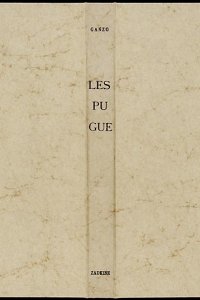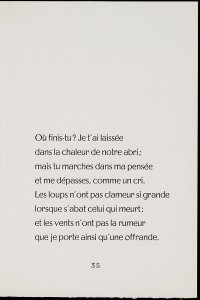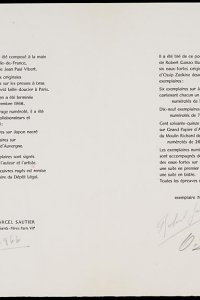Lespugue : poème
Year: 1966
Author: Robert Ganzo (1898 - 1995)
Artists: Ossip Zadkine (1888 - 1967)
Publisher: Marcel Sautier
Statue in Rotterdam
Many of Ganzo's poems were published privately, which doesn't mean that they weren't appreciated: his poetry was illustrated by some prominent artists. Lespugue was illustrated in 1942 by Jean Fautrier and in 1966 by Ossip Zadkine, among others, and it was also included in the collected works that were provided with illustrations by Jacques Villon in 1957. Editions also appeared with drawings by Jean Thomas and by the author himself. Fautrier's illustrations are lithographs printed by the Mourlot brothers, both figurative and sculptural in design. The six etchings by Ossip Zadkine from 1966 – the year in which he had his 76th birthday – were signed in the plate and printed by hand-press by Jacques David in Paris. One of the six etchings takes up two sheets. Embraces, entanglement, unification, passion and hugs are subjects that express a certain intensity through the use of hatching. Only the contours and the shading of the figures have been indicated, as though they were statues. The style of Zadkine, who is best known in the Netherlands for his statue of the destruction of Rotterdam, is clearly recognizable in this: expressive and cubist, with a lyrical touch.
Zadkine once stated that his calling as a sculptor was the result of a sweet tooth and a fall. He remembered spontaneously copying an image of a Cossack from the newspaper one evening, which was rewarded with a piece of pastry. A second memory took place by the river Dnyepr, where he stumbled and noticed his footprint in the clay. According to him, it was a platonic demon that first made him sculpt a figure out of the loam with an sense of delight he would never feel so strongly again.
The edition was set in the font face 'Ile-de-France' and printed in November 1966 at by printer Jean Paul Vibert in Paris. The copy that was sent to the Dépot légal, as was mandatory in France, contained the six copper plates, but they were made useless by scratches, so the number of prints could never be enlarged. The total edition consists of 200 copies, 25 of which on Japanese paper. This is number 92, one of the copies on handcrafted Grand Papier d'Auvergne from the paper mill of Richard de Bas. All copies were signed by Robert Ganzo and Ossip Zadkine. The publisher, Marcel Sautier, published a number of editions from World War II onwards that could be considered bibliophile works, including the collected poems of Ganzo, illustrated by Villon.
Bibliographical description
Description: Lespugue: poème / de Robert Ganzo ; ill. par Ossip Zadkine. - Paris : Marcel Sautier, 1966. - 61 p. : ill. ; 28 cm
1st edition: 1940
Printer: Jean Paul Vibert (text), Jacques David (Paris) (etchings)
Edition: 200 copies
This copy: Number 92 of 177 on Auvergne of Richard de Bas
Typeface: Ile-de-France
Note: Signed by the author and the artist
Bibliography: Bénézit 14-830 ; Monod-5114
Shelfmark: KW Koopm K 296
References
- Robert Goffin, Entrer en poésie. Paris, Poésie, 1948
- Ionel Jianou, Zadkine. Paris, Arted, 1964
- Maarten Jager, Ossip Zadkine, het onbekende oeuvre: Gouaches en aquarellen 1920-1966. Zwolle, Waanders; Deurne, Museum de Wieger, 2000
- Hans Knap, Valentine Prax & Ossip Zadkine: Portret van een kunstenaarshuwelijk. Rotterdam, Donker, 2001
- Ossip Zadkine, Le maillet et le ciseua: Souvenirs de ma vie. Paris, Michel, 1968
- O. Zadkine, Comment je suis devenu sculpteur. Brussel, Koninklijke Vlaamse Academie voor Wetenschappen, Letteren en Schone Kunsten van België, 1951





